Today's United States Marines have many idols. Unsurprisingly, these are often other Marines, Marines who served in wars past but distinguished themselves and exemplified what it means to call oneself a United States Marine. Few of these idols loom as large as Gunnery Sgt. John Basilone.
 Basilone was born to an Italian family in Upstate New York and raised in New Jersey. He was working as a golf caddy when he decided to join the Army in 1934. It was, of course, years before the United States entered World War II. He spent three years in the Philippines, a place he would come to love.
Basilone was born to an Italian family in Upstate New York and raised in New Jersey. He was working as a golf caddy when he decided to join the Army in 1934. It was, of course, years before the United States entered World War II. He spent three years in the Philippines, a place he would come to love.
Basilone loved Manila so much, in fact, that after he left the Army and became a truck driver, he decided he would re-enlist to get back to Manila as fast as possible. Thinking the Marine Corps would get him there faster, he joined the Marines instead of the Army in 1940. He was sent to Guantanamo Bay instead.
After the Japanese bombing of Pearl Harbor in 1941, the Marines went to war in the Pacific. By 1942, Basilone was sent to Guadalcanal in the Solomon Islands with the 1st Battalion, 7th Marines, and 1st Marine Division. John Basilone was about to make history while stacking many Japanese bodies.
The Marines on Guadalcanal found intense resistance from the Japanese defending the island. The 1/7th Marines were being hammered all along their defensive perimeter. Three thousand enemy soldiers from the Japanese Sendai Division came at the Marines with everything they could.
Then-Sgt. Basilone was in charge of two machine gun sections defending the perimeter. The enemy began blasting away at his sections using mortars and machine guns of their own until only Basilone and two of his Marines were left standing. To make matters worse, his guns had been cut off from the main American force by the Japanese assault. Things were beginning to look bleak.
 With ammunition critically low, Basilone fought his way through the enemy-occupied territory to bring his machine gunners the supplies and ammunition they needed. He even brought a heavy gun of his own to bring to bear against the onslaught. As they continued to fight on for two days, Basilone repaired another gun under heavy fire and was able to use that weapon as well.
With ammunition critically low, Basilone fought his way through the enemy-occupied territory to bring his machine gunners the supplies and ammunition they needed. He even brought a heavy gun of his own to bring to bear against the onslaught. As they continued to fight on for two days, Basilone repaired another gun under heavy fire and was able to use that weapon as well.
When ammunition began to run out, Basilone fought on with his sidearm and a machete. The Marines were not only able to hold the defensive line until relief arrived, they virtually annihilated the entire enemy unit. For his actions on Guadalcanal, which helped keep the critical Henderson Field in American hands, he was awarded the Medal of Honor.
But Basilone wasn't done. After a tour raising money for war bonds back in the United States, Basilone reenlisted in the United States Marine Corps and asked to be returned to combat duty. He arrived back in the Pacific Theater, newly married and attached to 1st Battalion, 27th Marine Regiment, 5th Marine Division.
 Basilone made it back to the front lines in time to join the Marines in the invasion of Iwo Jima, some of the bloodiest fighting of the entire war in any theater. Once more, Basilone was leading machine gun teams. But upon landing, the entire unit was pinned down by enemy machine gunners coming from blockhouses.
Basilone made it back to the front lines in time to join the Marines in the invasion of Iwo Jima, some of the bloodiest fighting of the entire war in any theater. Once more, Basilone was leading machine gun teams. But upon landing, the entire unit was pinned down by enemy machine gunners coming from blockhouses.
In a daring act of bravado under heavy fire, Basilone separated from his unit, headed toward the enemy blockhouses, and made his way on top of them. From his position atop the defenses, he used grenades and explosives to destroy the fortifications and their garrison inside, freeing his troops to advance.
The Marines then advanced toward an enemy airfield when they encountered an American tank trapped in a minefield. Under heavy Japanese small arms, mortar, and artillery fire, Basilone helped guide the tank out of the minefield and to safety. Sadly, he was killed in the effort.
Without John Basilone's bravery, his Marines might never have advanced off the beach. For his actions under fire, he was awarded the Navy Cross, the Marines' second-highest award. He is the only enlisted Marine to have received both the Medal of Honor and Navy Cross during World War II, so it's little wonder why his memory is revered by Marines to this day.
The U.S. Navy has had its wins and losses since its birthday on Oct. 13, 1775. Its victories are too numerous to count. While its losses are few and far between, two devastating losses stand out among all the others.
 Its most memorable significant loss is, of course, a day that continues to live in infamy. The Japanese attack on Pearl Harbor devastated the Navy's Pacific Fleet but did not cripple it. The Navy's first-ever significant is on par with Pearl Harbor but is often forgotten: The ill-fated Penobscot Expedition.
Its most memorable significant loss is, of course, a day that continues to live in infamy. The Japanese attack on Pearl Harbor devastated the Navy's Pacific Fleet but did not cripple it. The Navy's first-ever significant is on par with Pearl Harbor but is often forgotten: The ill-fated Penobscot Expedition.
In 1779, the Revolutionary War was in full swing. An American victory over British forces at Saratoga in 1777 brought recognition of the 13 American colonies from European powers like France and Spain. France allied itself with the new country, and the British Empire was forced to alter its strategy for dealing with the rebels.
A British force under Gen. Francis McLean captured a large portion of Maine, then part of the Massachusetts colony, and renamed it New Ireland. To reclaim the lost territory, Massachusetts assembled the largest naval expedition of the war.
A total force of 44 ships, including 19 warships and 25 support vessels, left Boston on July 19, 1779, bound for Castine, Maine, between the mouths of the Penobscot and Bagaduce Rivers. It was the same village at which the British landed to capture the area one month prior.
The flotilla was to land a force of 1,000 militiamen and colonial marines, along with a 100-strong artillery force under the command of Lt. Col. Paul Revere. Their first objective was to capture Fort George, a waypoint between the Royal Navy's station at Halifax, Nova Scotia.
 Though outnumbered by more than three-to-one, the bay at Castine was easily defensible, one of the primary reasons it was chosen by the British as the site of their stronghold between Canada and the rebellious American colonies.
Though outnumbered by more than three-to-one, the bay at Castine was easily defensible, one of the primary reasons it was chosen by the British as the site of their stronghold between Canada and the rebellious American colonies.
Some 2,000 sailors and their colonial land forces under Brig. Gen. Solomon Lovell arrived near the Penobscot River bay on July 25, 1779. The Royal Navy engaged the warships almost immediately, exchanging fire for more than four hours. As the warships fought, the Americans attempted to land their ground troops but were pushed back by heavy resistance.
The next day, colonial marines captured the British guns on nearby Nautilus Island. The force of militiamen were landed at the mouth of the Bagaduce but were turned back. Another force of 750 men landed and began to build the siege works. Two days later, the colonials landed another force, this time marines mixed with militia, to capture the fort.
American forces captured the heights around the fort, but at a cost. More than a quarter of the landing party were killed or wounded, and the Continental Navy frigate Warren was heavily damaged supporting the landing. As the ground troops assaulted the British forces, they lacked the one thing they needed to win: naval support.
 Commodore Dudley Saltonstall was in command of the American ships. After the casualties he took during the initial landings, he was hesitant to engage the British warships in the bay. Despite outnumbering the British ships, he kept out of range of the British guns, which gave the British naval superiority in the bay as the Americans mounted their attack on the fort.
Commodore Dudley Saltonstall was in command of the American ships. After the casualties he took during the initial landings, he was hesitant to engage the British warships in the bay. Despite outnumbering the British ships, he kept out of range of the British guns, which gave the British naval superiority in the bay as the Americans mounted their attack on the fort.
Pinned down by heavy British fire, the Americans were pinned down. They managed to take a battery of guns adjacent to the fort under cover of darkness, but when dawn broke the next day, Fort George began to pound the captured position.
The delays in taking the fort, combined with the reticence of the American flotilla, allowed the British time to send for reinforcements. A force of ten British warships was dispatched from New York on August 3rd. It arrived as Saltonstall finally began a naval attack on Fort George. The reinforcements forced the American ship upriver, pursued the whole way by the British.
By August 16th, most of the ships were scuttled or burned near Bangor, their crews forced to make their way home to Boston overland. The siege was broken, and the British continued their control over the northern areas of Massachusetts. British losses numbered 85 killed, wounded, or captured, while the colonial task force listed 474 killed, wounded, or captured.
Commodore Saltonstall's reluctance to engage the British fleet in the early days of the assault was blamed for the failure. Saltonstall was tried and sentenced to dismissal from the service. Fort George and the whole idea of New Ireland was abandoned in the terms of the 1783 Treaty of Paris that granted the colonies their independence.
It might come as a surprise to many, but the United States did not offer its troops medals or ribbons as uniform decorations until the Medal of Honor was introduced by President Lincoln during the Civil War. It was only offered to enlisted troops in July 1862, but by December, it was made available to officers who displayed exceptional gallantry.
 Until that point in U.S. military history, military medals were more of a European tradition. Medals and ribbons were seen as a custom practiced by the armies of foreign monarchies. The United States, with its democratic government and egalitarian principles, frowned on such ties to Europe's royal heritage, from which the Americans fought hard to separate themselves.
Until that point in U.S. military history, military medals were more of a European tradition. Medals and ribbons were seen as a custom practiced by the armies of foreign monarchies. The United States, with its democratic government and egalitarian principles, frowned on such ties to Europe's royal heritage, from which the Americans fought hard to separate themselves.
During the Mexican-American War, a 'certificate of merit' would be issued to soldiers who distinguished themselves in action, but no uniform item existed to identify them. It was simply a certificate. It was discontinued after that war ended in 1848.
Despite a lack of military decorations for the 86 years between the Declaration of Independence and the introduction of the Medal of Honor, three people were awarded medals. The only person who could have introduced an American medal over any objections was the Commander-In-Chief himself: George Washington.
 On August 7, 1782, Gen. George Washington created the Badge of Military Merit, a simple heart made of purple cloth. He awarded it to three men: Sgt. Elijah Churchill, Sgt. William Brown and Sgt. Daniel Bissel Jr. Washington intended the badge to be a recognition of 'any singularly meritorious action.' Only those three soldiers ever received it, and everyone forgot it ever existed.
On August 7, 1782, Gen. George Washington created the Badge of Military Merit, a simple heart made of purple cloth. He awarded it to three men: Sgt. Elijah Churchill, Sgt. William Brown and Sgt. Daniel Bissel Jr. Washington intended the badge to be a recognition of 'any singularly meritorious action.' Only those three soldiers ever received it, and everyone forgot it ever existed.
By 1932, the United States military had a number of decorations available for troops who fought in combat. The United States had entered World War I less than two decades prior, after all. Gen. Douglas MacArthur, who was the Army's Chief of Staff at the time, called for a revival of awards.
MacArthur wanted to not only recognize soldiers who performed meritorious acts, just as Washington's original badge had been. He also wanted to recognize the bicentennial of George, the first president's birthday. The medal he proposed featured purple cloth with a heart-shaped medal and Washington's profile on a purple background.
The Purple Heart was born. But the Department of the Army required that meritorious acts for which the medal would be awarded had to include a wound inflicted by the enemy. Ever since, the Purple Heart has been an award for such acts. When the Legion of Merit was established during World War II, the Purple Heart became an award solely for wounds in combat.
U.S. troops who had been awarded the Meritorious Service Citation Certificate, Army Wound Ribbon, or were authorized to wear wound chevrons were awarded the Purple Heart retroactive to the U.S. entry into World War I. MacArthur himself was the first person to be awarded the medal.

Steeped in secrecy and shaped by global Cold War tensions, the Vietnam War was, by all standards of measure, the most clandestine military campaign in US history. After World War II, democratic and communist nations were spoiling for a fight, testing one another, and positioning themselves to gain geographic and political advantage. However, with an indecisive outcome in Korea and escalating international anxiety, further activities became highly secretive on both sides, including CIA involvement in Vietnam beginning in 1953. Leading to covert 1961 combat operations in North Vietnam code-named Operation 34A, these highly classified and largely unsuccessful attacks reflected other events of that time, e.g., the Bay of Pigs (April 1961) and the Cuban Missile Crisis (October 1962). These CIA missions, comprised of air and naval infiltration, led to significant loss of life. To increase the chances of success, the Military Assistance Command, Vietnam- Studies and Observations Group (MACV-SOG) was created, and Operation 34A was transferred in July of 1964. Tasked initially with covert missions against Northern Vietnam, MACV-SOG entered the world of shadow warriors and covert operations, much of which remains classified to this time.
 Established on January 24, 1964, the Military Assistance Command, Vietnam – Studies and Observations Group (MACV-SOG) was a highly classified, multi-service special operations unit conducting covert and unconventional warfare, both before and during the Vietnam War. Created by the Joint Chiefs of Staff, MACV-SOG conducted strategic reconnaissance missions in South Vietnam, North Vietnam, Laos, and Cambodia, taking enemy prisoners, rescuing downed pilots and prisoners of war throughout Southeast Asia, and conducting clandestine agent team activities and psychological operations. It eventually consisted primarily of personnel from the United States Army Special Forces, the United States Navy SEALs, the United States Air Force (USAF), the Central Intelligence Agency (CIA), and elements of the United States Marine Corps Force Reconnaissance units- every one a volunteer. The force was above top secret - operatives were sworn to secrecy for over twenty years, which sadly meant that families of MACV-SOG members were not informed if their loved ones were killed in action. To prevent detection, SOG personnel carried no identification, uniforms were sterilized of all insignia, serial numbers were removed from their weapons, or captured enemy ordinance was used. Additionally, to best preserve the US assertion that no troops were operating outside South Vietnam, SOG reported directly to MACV, devoid of the military chain of command.
Established on January 24, 1964, the Military Assistance Command, Vietnam – Studies and Observations Group (MACV-SOG) was a highly classified, multi-service special operations unit conducting covert and unconventional warfare, both before and during the Vietnam War. Created by the Joint Chiefs of Staff, MACV-SOG conducted strategic reconnaissance missions in South Vietnam, North Vietnam, Laos, and Cambodia, taking enemy prisoners, rescuing downed pilots and prisoners of war throughout Southeast Asia, and conducting clandestine agent team activities and psychological operations. It eventually consisted primarily of personnel from the United States Army Special Forces, the United States Navy SEALs, the United States Air Force (USAF), the Central Intelligence Agency (CIA), and elements of the United States Marine Corps Force Reconnaissance units- every one a volunteer. The force was above top secret - operatives were sworn to secrecy for over twenty years, which sadly meant that families of MACV-SOG members were not informed if their loved ones were killed in action. To prevent detection, SOG personnel carried no identification, uniforms were sterilized of all insignia, serial numbers were removed from their weapons, or captured enemy ordinance was used. Additionally, to best preserve the US assertion that no troops were operating outside South Vietnam, SOG reported directly to MACV, devoid of the military chain of command.
Integral to accepting responsibility for Operation 34A in July 1964, MACV-SOG had an immediate and decisive impact on the war, leading to rapid escalation. Throughout 1963 the South Vietnamese regime of Ngo Dinh Diem was losing the war. Concerns intensified further when Diem was overthrown and killed in a CIA-sponsored coup in November, along with the assassination of President Kennedy. With MACV-SOG in place, on the night of July 30 and 31, 1964, four SOG PTF boats shelled islands off the coast of North Vietnam, the first time SOG employed seaborne shelling. At the same time, a SOG Agent Team was inserted into North Vietnam but was detected by the  Viet Cong. The very next afternoon, the destroyer USS Maddox began a coastal intelligence-gathering mission in the Gulf of Tonkin, prompting three Viet Cong torpedo boats to attack the Maddox on August 2nd, though the destroyer was undamaged. On the night of August 3rd and 4th, three SOG vessels again shelled targets on the mainland of North Vietnam. Joined by the destroyer USS Turner Joy on August 4th, the Maddox reported to Washington that both ships were under attack by unknown vessels, assumed to be North Vietnamese. In response, President Johnson launched Operation Pierce Arrow, an aerial attack against North Vietnamese targets. Moreover, and of historical importance, Congress authorized the Southeast Asia Resolution giving President Johnson power to do whatever was necessary to support the Southeast Asia Collective Defense Treaty- without a declaration of war. Unknown to Congress, however, was that SOG operations were conducted in the same area as the Maddox, and there was only a single Viet Cong attack on US vessels.
Viet Cong. The very next afternoon, the destroyer USS Maddox began a coastal intelligence-gathering mission in the Gulf of Tonkin, prompting three Viet Cong torpedo boats to attack the Maddox on August 2nd, though the destroyer was undamaged. On the night of August 3rd and 4th, three SOG vessels again shelled targets on the mainland of North Vietnam. Joined by the destroyer USS Turner Joy on August 4th, the Maddox reported to Washington that both ships were under attack by unknown vessels, assumed to be North Vietnamese. In response, President Johnson launched Operation Pierce Arrow, an aerial attack against North Vietnamese targets. Moreover, and of historical importance, Congress authorized the Southeast Asia Resolution giving President Johnson power to do whatever was necessary to support the Southeast Asia Collective Defense Treaty- without a declaration of war. Unknown to Congress, however, was that SOG operations were conducted in the same area as the Maddox, and there was only a single Viet Cong attack on US vessels.
Central to accelerating US involvement throughout Southeast Asia, SOG participated in the most significant campaigns of the Vietnam War, including Operation Steel Tiger, Operation Tiger Hound, the Tet Offensive, Operation Commando Hunt, and the Cambodian Campaign Operation Lam Son 719, and the Easter Offensive. Officially SOG was authorized for a wartime high of 394 US personnel, but to accomplish their missions, support was necessary from a number of Army, Air Force, Marine, and South Vietnamese units that totaled 10,210 military and civilian personnel working for MACV-SOG, including seven CIA operatives. To manage the growing complexities, SOG developed Operational Groups (Maritime, Airborne, Psychological, and Air) commanded from headquarters in Saigon, increasing in size and scope throughout the war.
 Perhaps the least known aspect of SOG's original missions consisted of psychological operations conducted against North Vietnam and comprised of radio broadcasts (e.g., "Voice of the SSPL"), leaflet drops, and gift kits containing pre-tuned radios which could only receive broadcasts from the unit's transmitters. SOG also broadcast "Radio Red Flag,” programming purportedly directed by a group of dissident communist military officers. Both stations condemned the PRC, the South and North Vietnamese regimes, and the US in favor of traditional Vietnamese values. Straight news, without propaganda embellishment, was broadcast from South Vietnam via the Voice of Freedom, another SOG creation.
Perhaps the least known aspect of SOG's original missions consisted of psychological operations conducted against North Vietnam and comprised of radio broadcasts (e.g., "Voice of the SSPL"), leaflet drops, and gift kits containing pre-tuned radios which could only receive broadcasts from the unit's transmitters. SOG also broadcast "Radio Red Flag,” programming purportedly directed by a group of dissident communist military officers. Both stations condemned the PRC, the South and North Vietnamese regimes, and the US in favor of traditional Vietnamese values. Straight news, without propaganda embellishment, was broadcast from South Vietnam via the Voice of Freedom, another SOG creation.
By September 1965, the Pentagon authorized MACV-SOG to begin cross-border operations in Laos along South Vietnam's western border, though not officially acknowledged until 1971. MACV wanted boots on the ground since 1964 to observe the enemy logistical system operating on and around the Ho Chi Minh Trail. Earlier strategic bombing efforts in April (Operation Steel Tiger), through the 7th Air Force, were wholly unsuccessful. Equally, all-Vietnamese reconnaissance efforts (Operation Leaping Lena) proved disastrous. US troops were necessary, and SOG launched Laotian operations beginning in October 1965. In what became a longstanding practice, SOG conducted prisoner snatch missions behind enemy lines along the Ho Chi Minh Trail. No matter the primary mission, capturing enemy soldiers remained the team's secondary objective to gather valuable intelligence relating to troop movements, size, and base locations. However, teams also received rewards, including free R&R trips to Taiwan or Thailand, a $100 bonus for each US team member, a Seiko watch, and cash to each indigenous member. SOG most often operated using teams comprised of two-to-three Americans and six-to-nine indigenous personnel (Vietnamese, Montagnards, Cambodians, or ethnic Chinese). When launching a cross-border recon operation, SOG teams would enter a pre-mission “quarantine,” much like modern-day Army Special Forces operational detachments do before deploying. During this quarantine period, they would eat the same food as the North Vietnamese, so they- and their human waste- would smell like the enemy while in the jungle.
 During 1966 it became obvious the North Vietnamese were using Cambodia, a supposedly neutral country, as part of their logistical system. However, the extent of operations was unknown. In April 1967, MACV-SOG was ordered to commence Operation Daniel Boone, a cross-border reconnaissance effort into Cambodia, though, like Laos, not acknowledged until 1970. But unlike Laos, SOG and the 5th Special Forces Group were initially constrained in their efforts. Reconnaissance teams had to cross the border on foot, had no tactical air support or Forward Air Controllers, and relied almost solely on stealth. Though SOG's Air Operations Group had been augmented in September 1966, alongside support by the 15th Air Commando Squadron and the 20th Special Operations Squadron, air support was not authorized in Cambodia until much later, and then in the form of dedicated Huey gunships and transport.
During 1966 it became obvious the North Vietnamese were using Cambodia, a supposedly neutral country, as part of their logistical system. However, the extent of operations was unknown. In April 1967, MACV-SOG was ordered to commence Operation Daniel Boone, a cross-border reconnaissance effort into Cambodia, though, like Laos, not acknowledged until 1970. But unlike Laos, SOG and the 5th Special Forces Group were initially constrained in their efforts. Reconnaissance teams had to cross the border on foot, had no tactical air support or Forward Air Controllers, and relied almost solely on stealth. Though SOG's Air Operations Group had been augmented in September 1966, alongside support by the 15th Air Commando Squadron and the 20th Special Operations Squadron, air support was not authorized in Cambodia until much later, and then in the form of dedicated Huey gunships and transport.
Early on, SOG involvement was growing and becoming more diverse. In September 1966, the Joint Personnel Recovery Center (JPRC) was established by MACV and immediately assigned to SOG. The JPRC was to compile information on POWs, MIA, and escapees, planning missions to free and recover US and allied personnel. Additionally, SOG was responsible to conduct post search and rescue (SAR) operations when all other efforts had failed. SOG carried on this mission until the unit was disbanded in 1972, at which time responsibility to repatriate some 2,500 missing military and civilian personnel passed to a successor organization, the Joint Casualty Resolution Center (JCRC). Operationally, by 1967 MACV-SOG had also assumed the role of supporting construction for the Muscle Shoals electronic barrier system, including reconnaissance and placement of electronic sensors both in the western Demilitarized Zone and southeastern Laos.
 Success in the war through 1967 continues to be controversial, but there is no denying that 1968 was pivotal, signaling a downturn for US forces despite escalating troop commitments. For SOG specifically, the Tet Offensive, the largest Communist assault to that time, inflicted severe losses and caused a collapse of northern operations. Reportedly, the communists offered a medal for any NVA soldier that killed a SOG member. For most of the year, MACV-SOG centered around in-country missions supporting field forces. However, on the morning of October 5th, all that would change with a reconnaissance mission by Recon Team Alabama that proved legendary. The insertion of Alabama's nine-man team started smoothly enough, but almost immediately, an NVA flag was spotted, signaling regimental strength in the area. Rather than abort, the team continued on, but only to realize the mission had been compromised, and they were walking into an ambush. In the ensuing melee, growing numbers of NVA were killed as Team Alabama was encircled, and the enemy dead were stacked up to create a perimeter wall. Over the next several hours, Phantom jets dropped napalm on advancing enemy troops while helicopter gunships resupplied the soldiers of Team Alabama and provided supporting fire. Under the leadership of Specialist Fourth Class Lynne M. Black Jr. and Cowboy, a South Vietnamese Team Leader, extraction was ultimately achieved. Only after the engagement was it determined that an NVA division numbering 10,000 had been committed to the action, with ninety percent killed or wounded.
Success in the war through 1967 continues to be controversial, but there is no denying that 1968 was pivotal, signaling a downturn for US forces despite escalating troop commitments. For SOG specifically, the Tet Offensive, the largest Communist assault to that time, inflicted severe losses and caused a collapse of northern operations. Reportedly, the communists offered a medal for any NVA soldier that killed a SOG member. For most of the year, MACV-SOG centered around in-country missions supporting field forces. However, on the morning of October 5th, all that would change with a reconnaissance mission by Recon Team Alabama that proved legendary. The insertion of Alabama's nine-man team started smoothly enough, but almost immediately, an NVA flag was spotted, signaling regimental strength in the area. Rather than abort, the team continued on, but only to realize the mission had been compromised, and they were walking into an ambush. In the ensuing melee, growing numbers of NVA were killed as Team Alabama was encircled, and the enemy dead were stacked up to create a perimeter wall. Over the next several hours, Phantom jets dropped napalm on advancing enemy troops while helicopter gunships resupplied the soldiers of Team Alabama and provided supporting fire. Under the leadership of Specialist Fourth Class Lynne M. Black Jr. and Cowboy, a South Vietnamese Team Leader, extraction was ultimately achieved. Only after the engagement was it determined that an NVA division numbering 10,000 had been committed to the action, with ninety percent killed or wounded.
Meanwhile, peace negotiations were stalled, and the US was anxious to reopen discussions with Hanoi. Though North Vietnam was looking for the US to cease its air campaign (Operation Rolling Thunder), President Johnson instead enacted a cessation of all US operations north of the 20th parallel, both overt and covert. This order effectively ended MACV-SOG's agent team, propaganda, and  aerial operations. In reality, intelligence returns from the northern agent teams had been disappointing, and more than three-quarters of the agents inserted, some 456 South Vietnamese, had been captured. Years after the war ended, it was discovered there was a mole at the SOG headquarters in Saigon, passing information on team missions and locations to the enemy.
aerial operations. In reality, intelligence returns from the northern agent teams had been disappointing, and more than three-quarters of the agents inserted, some 456 South Vietnamese, had been captured. Years after the war ended, it was discovered there was a mole at the SOG headquarters in Saigon, passing information on team missions and locations to the enemy.
Consequently, by 1970 SOG found their time on the ground both shortened and more dangerous, evidenced by more and more teams being eradicated. In fact, MACV-SOG had a casualty rate exceeding 100%, one of the highest of any US force. This translates to every single SOG officer being wounded at least once and over half of the force killed in action.
The US military and MACV-SOG kept tight security over the unit's existence until the early 1980s. The unit was downsized and renamed Strategic Technical Directorate Assistance Team 158 on May 1, 1972, to support the transfer of its work to the Army of the Republic of Vietnam under the Vietnamization program. In recognition of their contributions, bravery, and devotion to duty, MACV-SOG was awarded a Presidential Unit Citation (April 2001), thirteen Congressional Medals of Honor, twenty-two Distinguished Service Crosses, and a host of others. Service with SOG meant a life filled with peril and the likelihood of dying in anonymity. But, for this elite, all-volunteer force, it also came with the reassurance of working alongside the best and confidence borne from an unbreakable bond of loyalty and trust.
"When General Noriega came to power, my father's company went to hell in a handbasket," Kurt Muse recalled at the Silent Warrior Foundation's annual Whiskey and War Stories event. "He killed a very dear friend of mine. My family was fearful of the roadblocks set up by the army. My kids were scared to death.
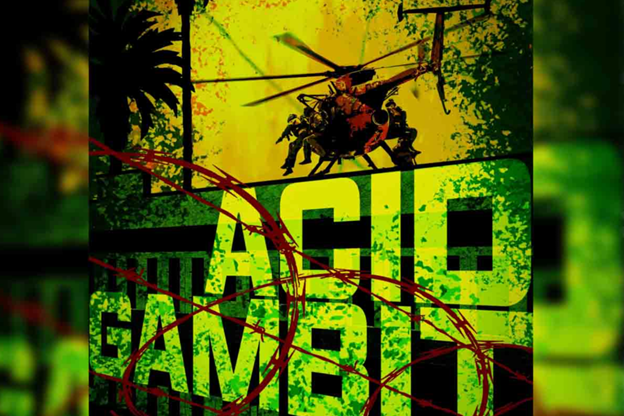 "I just reached a breaking point. So I decided to do what every red-blooded American would do: overthrow the government."
"I just reached a breaking point. So I decided to do what every red-blooded American would do: overthrow the government."
Muse was an American who had been living in Panama for decades when nationalist dictator Manuel Noriega took control of the government in 1983. By 1989, Muse would be a political prisoner in Noriega's notorious Carcel Modelo prison in Panama City.
"This prison was horrible," Muse said. "The people that go there, die there. You don't make license plates, yo get tortured and die there."
Gen. Noriega promised that the first bullet fired in a war between the United States and Panama would be the one that killed Muse. Instead, that bullet came from the rifle of the U.S. Army Special Forces in a rescue mission called Acid Gambit.
Every year, the Silent Warrior Foundation brings together key figures in famous special operations missions to discuss the behind-the-scenes events and untold stories of these famous missions. Headlining the 2022 event was Muse, his wife Anne and some of the soldiers and pilots who came to his rescue.
Muse had lived in Panama since he was five years old. He grew up with Panamanian children, and learned in Panamanian schools. His family ran a business there. Though he was an American citizen, it was a place he'd grown to love.
As Noriega rose to power, Muse came to realize that the regime threatened his business, his family and his beloved Panama itself. Noriega had to go.
In Noriega's Panama, radio equipment was illegal, but Muse and a close group of associates had access to such equipment through their business connections in the United States. Owning unlicensed radio equipment meant torture and death at the hands of the government.
At first, they used this gear to annoy the Panamanian Defense Forces (PDF) by threatening them with sniper fire, sending them on false missions and other pranks. In 1987, the pranks turned into full-blown resistance.
A close associate discovered that the signal from the government's radio station, La Nacional, could easily be overpowered by their radio equipment. On Oct. 11, 1987, Noriega was set to give a national speech celebrating Loyalty Day to a packed baseball stadium. It would be broadcast to the whole country via La Nacional.
As Noriega began to speak, Muse and his associate superseded the signal and replaced it with a broadcast of their own. They played a message encouraging Panamanian citizens not to be afraid of the PDF on election day, to go to the polls and to vote Noriega out of power. La Voz de la Libertad, the Voice of Liberty, was born.
In the days leading to election day, La Voz de la Libertad broadcast many similar messages, usurping the La Nacional signal for every one of them. The me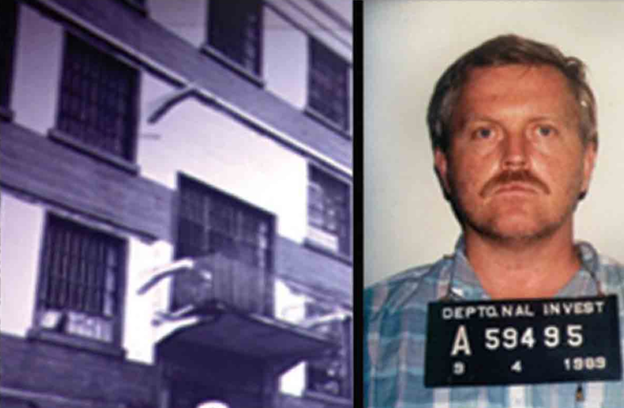 n continued their resistance. If any one of them were compromised, they were to warn the others by any means necessary with one simple word: shopette.
n continued their resistance. If any one of them were compromised, they were to warn the others by any means necessary with one simple word: shopette.
Muse's wife, Anne, was a teacher on the U.S. Army's Fort Clayton in the Panama Canal Zone at the time. Muse and his compatriots often conducted their resistance activities on the base. When thinking about how to handle getting caught, they were walking by the base shopette. That's how it became La Voz de la Libertad's distress signal.
The signals continued for years, broadcasting anti-Noriega messages and encouraging voters to go to the polls:
"You know the many tools that the oppressors have to keep us from the polling places. We beseech you to be brave, to persevere. We beseech you to vote. Together we can bury Gen. Noriega's dictatorship under a mountain of ballots."
The plan to get voters to the polls worked. The part about unseating Noriega was thwarted by the general himself. As the votes were counted and it became clear that Noriega was losing, PDF troops began to seize ballot boxes. The result was voided and the opposition badly beaten, as the general installed a longtime crony as president.
He would eventually bestow himself with the title of "Maximum Leader" of Panama, a title only he recognized.
As Noriega began to lose favor with the U.S. government, La Voz de la Libertad began receiving support from the U.S. State Department and the CIA. Muse was not, as is often reported, working for the CIA. Soon, the resistance cell had transmitters interrupting La Nacional in multiple locations.
In March 1989, Muse was returning to Panama from a family trip to the United States (where he also met with a State Department official), when he was suddenly arrested by customs officers. He later found out he was betrayed by the wife of a fellow rotary club member who knew about his activities. She had fallen into debt at a Panama City casino and passed information to the PDF in exchange.
Luckily for La Voz de la Libertad, a fellow associate was also on the flight. When Muse failed to emerge from the airport, that member of La Voz sent the distress word out to the other members of the resistance: shopette.
Muse was held without charges in Panama's Carcel Modelo prison for nine months. It was his status as a Department of Defense dependent under the Panama Canal Treaty that saved him from the torture and execution. If Muse died, Panama would have to return the canal to the United States.
"I was subject to days of intense interrogation," Muse recalled. "I didn't get to sleep for about four days, nonstop. I'm going cuckoo from lack of sleep. They tell me they captured my daughter, and if I didn't confess, they would torture her."
Muse never revealed the involvement of others, even as the PDF uncovered apartments filled with radio equipment and discovered Muse's cash transactions. The State Department and CIA worked for months to secure his release but to no avail; Noriega began publicly referring to Muse as a hostage.
"I wouldn't confess to anything," said Muse. "I would not give up my confederates. I'm the author of this job, I will pay the piper. Period."
As Muse's capture became a cause célèbre back in the U.S., Noriega became increasingly paranoid about an American invasion. He publicly stated that the first casualty of a war between the United States and Panama would be Kurt Muse.
The dictator even posted a soldier with a machine gun outside of Muse's cell, a 24/7, on-call executioner.
Then Noriega suddenly declared that a state of war existed between the U.S. and Panama. A few days after that declaration, Dec. 16, 1989, PDF troops killed Marine Corps 1st Lt. Robert Paz. Safeguarding the 35,000 other American troops in Panama was the justification President George H.W. Bush needed to launch an invasion.
As 27,000 U.S. troops began Operation Just Cause, 23 Delta operators and four MH-6 Little Bird helicopters from the Army's 160th Special Operations Aviation Regiment launched Operation Acid Gambit.
At the same time as the U.S. invaded Panama, the Army was going to rescue Muse. The moment the Special Forces' shape charge blew a hole in the prison's rooftop door, AC-130 gunships began leveling Noriega's comandancia, his official headquarters building, just across the street from the prison.
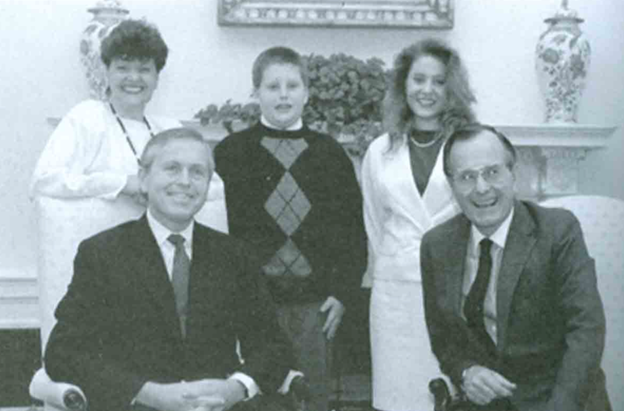 In an operation that took about six minutes, soldiers entered the Modelo prison, neutralized Muse's would-be assassin and took their precious cargo to the roof.
In an operation that took about six minutes, soldiers entered the Modelo prison, neutralized Muse's would-be assassin and took their precious cargo to the roof.
Noriega fled almost as soon as the invasion began. He eventually took refuge in the Vatican City's embassy in Panama City, which was soon surrounded by American troops. After 10 days of blasting rock music at the embassy all day and night, Noriega finally surrendered.
Operation Just Cause ended after just more than five weeks. Noriega was convicted of drug trafficking charges in the United States, his PDF was dissolved and the rightful winner of the 1989 Panamanian elections, Guillermo Endara, took office.
Muse was soon reunited with his family, who had been exfiltrated from the country by the CIA not long after Kurt was captured by the PDF. Every year, on the anniversary of Operation Acid Gambit, Muse calls the Delta soldiers who rescued him to update them on what's new in his life.
The full story of Muse's arrest and liberation can be found in his book, "Six Minutes to Freedom," which he co-wrote with author John Gilstrap.
 Some say the decades between 1930 and 1970 were the golden age of aviation. For many pilots, this was certainly the case. Aviation technology took a great leap forward during and after World War II. Pilots began testing the limits of their craft, from altitude to the sound barrier. Most importantly, the years saw the creation of the U.S. Air Force as an independent military branch.
Some say the decades between 1930 and 1970 were the golden age of aviation. For many pilots, this was certainly the case. Aviation technology took a great leap forward during and after World War II. Pilots began testing the limits of their craft, from altitude to the sound barrier. Most importantly, the years saw the creation of the U.S. Air Force as an independent military branch.
Starting from a must-win air war like World War II, pilots like Col. Richard Ernest Evans could really make a name for themselves and thrive in the skies. Growing up in Knoxville, Tennessee, Evans was practically born to serve. He started his service life with the Eagle Scouts and became a B-17 Flying Fortress pilot in the Mediterranean theater of World War II.
He continued his service after the war as Deputy Director of Operations for the USAF Strategic Air Command. During the Cold War, he was promoted to colonel and was the commander of the B-58 test squadron. He then went to work for North American Aircraft Company, continuing his aviation career.
While deployed to the Mediterranean, he flew 54 combat missions over North Africa, Italy, and Germany. Most of these were flown in the "Theresa Leta," his B-17E Flying Fortress. One of the most notable missions in Col. Evans' war record came between June 13 and August 5, 1943. During this time period, he was Gen. (later Field Marshal) Bernard Montgomery's pilot, ferrying the famed British commander between his staff and his Army in the field.
After serving in Europe and North Africa, Col. Evans was transferred back to the mainland United States, where he learned to fly a new plane, the B-29 Superfortress. Evans was sent to the Pacific Theater in March 1945, where he flew one bombing mission over Japan before the Japanese surrendered later that year.
 The rest of his time in the Air Force was spent first in the reserves before being activated again for the Korean War. After that, he became a test pilot, flying the B-47, B-52, and B-58 - the first strategic American bomber capable of flying at Mach 2.
The rest of his time in the Air Force was spent first in the reserves before being activated again for the Korean War. After that, he became a test pilot, flying the B-47, B-52, and B-58 - the first strategic American bomber capable of flying at Mach 2.
Col. Evans' time in the Army and later Air Force was truly a golden age for pilots in general, as well as a golden age for himself. Before he died in 2006, he wrote 21 chapters of the book that would become "Richard Eager: A Pilot's Story from Tennessee Eagle Scouts to General Montgomery's 'Flying Fortress'" at the behest of his son and daughter.
The book is filled with interesting and funny stories from his youth, training, missions over Axis targets, and of course, his time with "Monty." Although he was unable to find a publisher for his book before he died, his daughter, Barbara Kinnear, promised she would publish it after his death.
Unfortunately, a 2008 wildfire destroyed Evans' home and his original manuscript. Kinnear meticulously recreated the stories using well-researched material, finally restoring her father's cherished memories.
"My father was a wonderful storyteller. He wrote with humor and humility and with an understanding of the value of history. His stories will remind others of the importance of family, long-honored values, and facing one's fears," Kinnear told the UT Daily Beacon in 2022.
Just in time to celebrate the 75th birthday of the United States Air Force, Richard Eager: A Pilot's Story from Tennessee Eagle Scouts to General Montgomery's 'Flying Fortress is available in hardcover, paperback, and digital formats, wherever books are sold, including Amazon and Walmart.
When South Vietnam fell to North Vietnamese forces in 1975, an estimated 125,000 Vietnamese refugees fled to the United States to avoid retribution at the hands of the North Vietnamese.
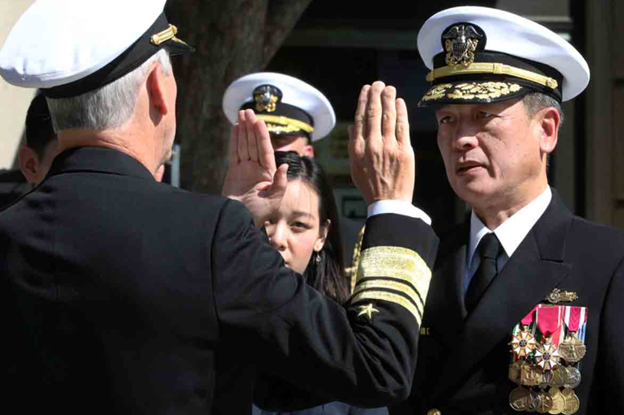 Among those refugees was U.S. Navy Rear Adm. Huan Nguyen, the first Vietnamese-American ever to hold flag rank. Nguyen's road to becoming a distinguished Navy officer was a long and tragic one and began with one of the war's most iconic photographs.
Among those refugees was U.S. Navy Rear Adm. Huan Nguyen, the first Vietnamese-American ever to hold flag rank. Nguyen's road to becoming a distinguished Navy officer was a long and tragic one and began with one of the war's most iconic photographs.
"America is the beacon of hope for all of us. There is no other place in the world where a person can go for such opportunity," Nguyen said at his 2019 promotion ceremony.
Eddie Adams' photo of Viet Cong guerrilla Bay Lop being executed by South Vietnamese Gen. Nguyen Ngoc Loan made newspapers around the world in 1968. It became one of the most enduring images of the Vietnam War.
The photo fueled the anti-war movement back in the United States, which saw the photo as proof that the war was unjustified. But Adams' photo only tells half the story, as the former Marine Corps photographer admitted.
Bay Lop was executed in Saigon on the second day of the Tet Offensive. He was captured after murdering South Vietnamese Lt. Col. Nguyen Tuan, along with the officer's wife, mother, and six of his children. One of his children survived, however, after being shot through the arm and thigh. Another bullet pierced his skull.
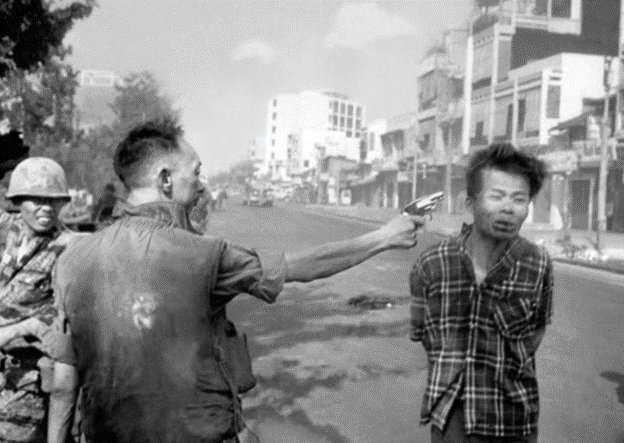 Nine-year-old Huan Nguyen stayed next to his mother for two hours after the murders.
Nine-year-old Huan Nguyen stayed next to his mother for two hours after the murders.
When night fell, he escaped the scene and avoided the communist guerrillas. The young boy was taken in by his uncle, a colonel in the South Vietnamese Air Force. After the fall of Saigon in 1975, the officer and Nguyen escaped to the United States.
U.S. Navy and Marine Corps troops took care of the family as they made their way through Guam, along with thousands of other refugees, before being sponsored for relocation in the United States. U.S. Air Force Col. Ed Veiluva sponsored the family, which was resettled in Oklahoma as political refugees.
By 1981, Nguyen earned a bachelor's degree in electrical engineering from Oklahoma State University. He later earned master's degrees in electrical engineering, engineering, and information technology. In 1993, he received a direct commission in the U.S. Navy through the Reserve Engineering Duty Officer Program.
Huan Nguyen was promoted to rear admiral in October 2019, at the time the highest-ranking Vietnamese-born officer in the U.S. military.
"The images that I remember vividly when I arrived at Camp Asan, Guam, now Asan Beach Park, were of American sailors and Marines toiling in the hot sun, setting up tents and chow halls, distributing water and hot food, helping and caring for the people with dignity and respect," Nguyen said.
"I thought to myself how lucky I am to be in a place like America. Those sailors inspired me to later serve in the United States Navy."
After the end of World War II and Japan's surrender, Enewetak came under the control of the United States as part of the Trust Territory of the Pacific Islands until the independence of the Marshall Islands in 1986. During its tenure, the United States evacuated the local residents many times, often involuntarily. The atoll was used for nuclear testing as part of the Pacific Proving Grounds. Before testing commenced, the U.S. exhumed the bodies of United States servicemen killed in the Battle of Enewetak and returned them to the United States to be re-buried by their families.
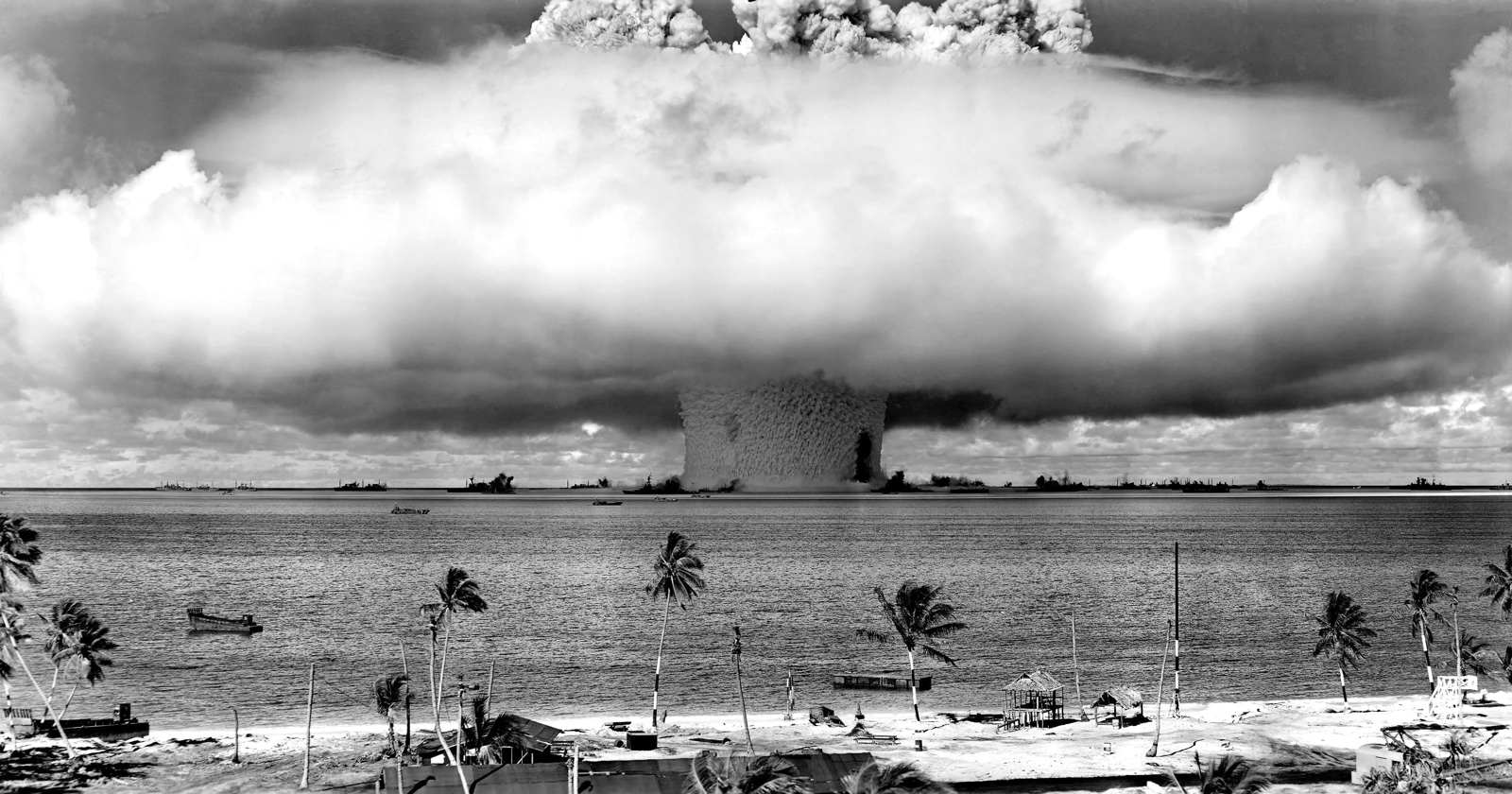 Forty-three nuclear tests were fired at Enewetak from 1948 to 1958.
Forty-three nuclear tests were fired at Enewetak from 1948 to 1958.
Enewetak Atoll formed atop a seamount. The seamount was formed in the late Cretaceous period. This seamount is now about 1,400 meters (4,600 ft) below sea level. It is made of basalt, and its depth is due to a general subsidence of the entire region and not because of erosion.
Enewetak has a mean elevation above sea level of 3 meters (9.8 ft)
At least 4,000 service members were dispatched in the late 1970s to clean up the fallout from U.S. atomic bomb tests conducted in the Marshall Islands several decades earlier.
In a 10-year period that ended in 1958, 43 tests were conducted at Enewetak Atoll, the ring-shaped collection of 40 coral reef islands. For the next 20 years, the contamination sat atop the atoll, 850 miles west of Hawaii.
By the 1970s, under threat of legal action by island natives, the U.S. launched a haphazard and dangerous plan to clean it up. The military would execute it.
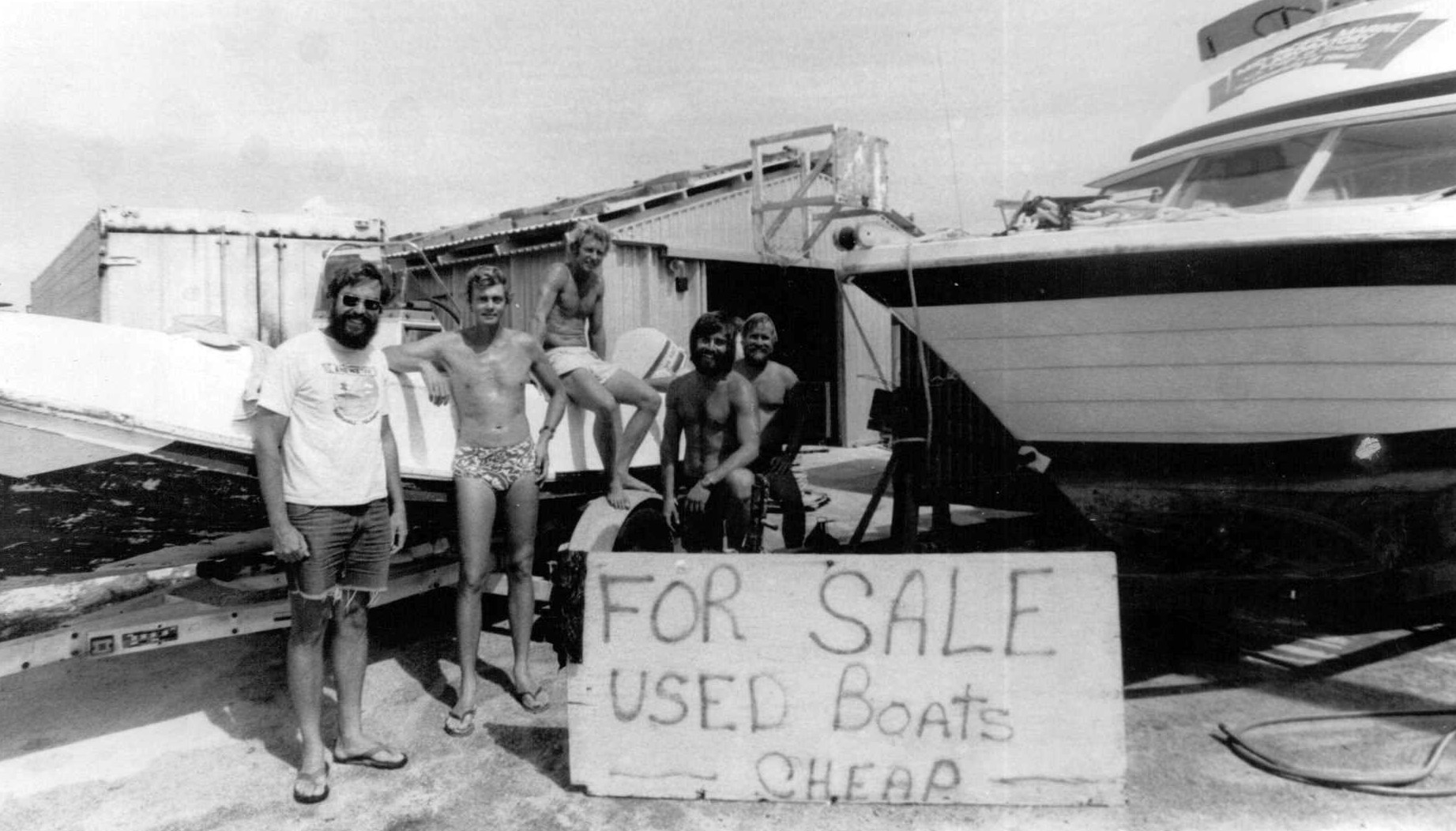 Wearing not much more than shorts, servicemembers used shovels, bulldozers, and other heavy equipment to scrap radioactive materials from the islands, breathing in deadly powder along the way. The plutonium-infested debris was dumped inside a crater from a previous test at Enewetak's Runit Island.
Wearing not much more than shorts, servicemembers used shovels, bulldozers, and other heavy equipment to scrap radioactive materials from the islands, breathing in deadly powder along the way. The plutonium-infested debris was dumped inside a crater from a previous test at Enewetak's Runit Island.
The Enewetak Atoll cleanup veterans, many of whom faced a long list of cancers and other deadly illnesses, are mostly gone today. Groups that track them estimate there are only about 400 left today.
How did they get here?
It's a long way from CONUS and 850 miles from Hawaii.
Men from the 110th Naval Construction Battalion arrived on Enewetak between 21 and 27 February 1944 and began clearing the island for the construction of a bomber airfield. A 2,100-meter (6,900 ft) by 120-meter (390 ft) runway with taxiways and supporting facilities was built. The first plane landed on 11 March. By 5 April, the first operational bombing mission was conducted. The base was later named for Lieutenant John H. Stickell.
The Imperial Japanese Navy had developed a seaplane base on Parry Island. Following its capture on 22 February, Seabees from the 110th Naval Construction Battalion expanded the base, building a coral-surfaced parking area and shops for minor aircraft and engine overhauls. A marine way was installed on a Japanese pier, and boat-repair shops were also erected.
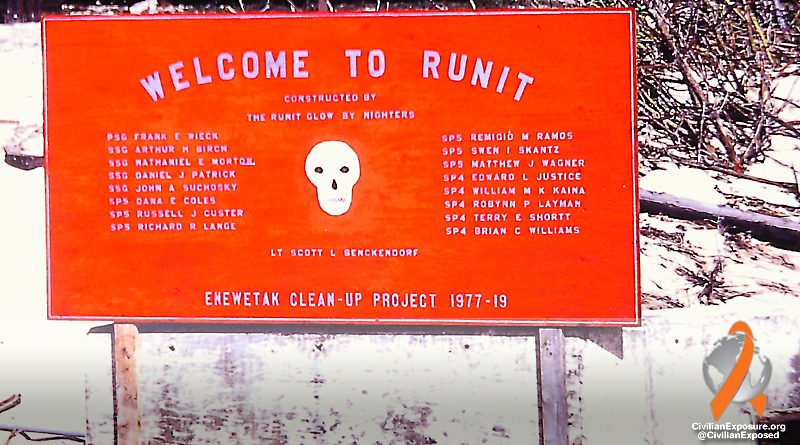 What did the US servicemembers do?
What did the US servicemembers do?
During the three-year, US$100 million cleanup process, the military mixed more than 80,000 cubic meters (100,000 cubic yards) of contaminated soil and debris from the islands with Portland cement and buried it in an atomic blast crater on the northern end of the atoll's Runit Island. The material was placed in the 9.1-meter (30 ft) deep, 110-meter (360 ft) wide crater created by the May 5, 1958, "Cactus" nuclear weapons test. A dome composed of 358 concrete panels, each 46 centimeters (18 in) thick, was constructed over the material.
The final cost of the cleanup project was $239 million.
Many worked 10 to 12 hours a day, six days a week, painstakingly removing six inches of topsoil from the islands. The radioactive debris was dumped at Cactus Crater, the 300-foot-long divot named for its namesake test in 1958 at Runit Island.
A backstory of Department of Defense Nuclear testing in the Pacific
The first hydrogen bomb test, code-named Ivy Mike, occurred in late 1952 as part of Operation Ivy; it vaporized the islet of Elugelab. This test included B-17 Flying Fortress drones to fly through the radioactive cloud to test onboard samples. B-17 mother ships controlled the drones while flying within visual distance of them. In all 16 to 20 B-17s took part in this operation, of which half were controlling aircraft and half were drones. To examine the explosion clouds of the nuclear bombs in 1957/58, several rockets (mostly from rockoons) were launched. One USAF airman was lost at sea during the tests.
 The personal impact:
The personal impact:
The United States government declared the southern and western islands in the atoll safe for habitation in 1980, and residents of Enewetak returned that same year. The military members who participated in that cleanup mission are suffering from many health issues, but the U.S. Government is refusing to provide health coverage.
Ron Madden didn't think much of his first tooth falling out when he was 29. But when most of his teeth fell out the next year, the former Army heavy equipment operator started to worry. In the next three decades, Madden developed three forms of cancer, bone pain, severe joint weakness, and trouble using his arms and legs.
Keith Kiefer found out he was suffering from degenerative bone disease and spinal stenosis, which causes pain in the spinal cord area. He's had both his hips replaced in recent years. In his 40s, "I was told I had the skeletal structure of a 90-year-old," he said. Kiefer has also been diagnosed with a non-diabetic form of peripheral neuropathy, another radiation-connected illness.
The Enewetak Atoll veterans, unlike the atomic veterans who participated in the tests, don't get disability coverage for their toxic exposure.
In 2019, lawmakers refiled legislation to extend VA benefits to this newer generation of atomic veterans. The Mark Takai Atomic Veterans Healthcare Parity Act of 2019, named for a late Hawaii lawmaker, would close the gap in benefits between the atomic vets who participated in the tests and those who cleaned up the fallout.
House Bill 1377, sponsored by Rep. Grace Meng, D-N.Y., and 119 other lawmakers, and its counterpart in the upper chamber, Senate Bill 555, authored by Sen. Tina Smith, D-Minn., and co-sponsored by 15 more senators, have stalled since the legislation was introduced in late February. Both bills died in committee.
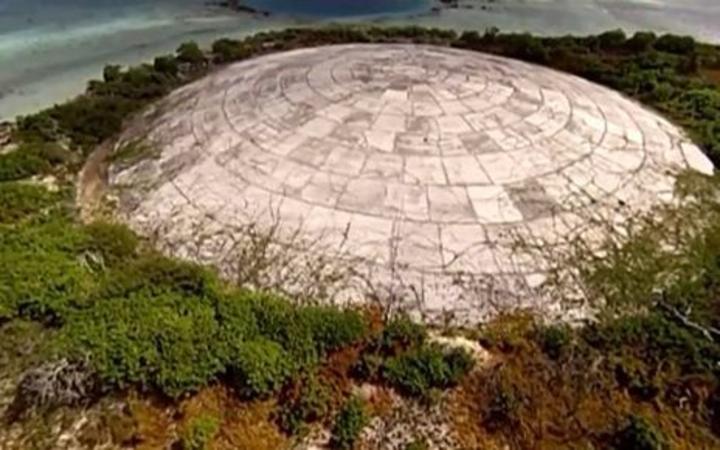 What's next?
What's next?
In September 1979, the Runit Dome, known locally among the natives as "The Tomb," was capped. There was no rebar or other structural support to keep the concrete from cracking, Sargent said.
It's a haunting fixture for the locals known as Marshallese and others. In May, United Nations Secretary General Antonio Guterres delivered a harsh warning that the "coffin" of radioactive material could be leaking.
"It's going to eventually breach and go into the ocean," Sargent said. "There are big-time cracks. We never put any liners or stuff we were supposed to do.
 Basilone was born to an Italian family in Upstate New York and raised in New Jersey. He was working as a golf caddy when he decided to join the Army in 1934. It was, of course, years before the United States entered World War II. He spent three years in the Philippines, a place he would come to love.
Basilone was born to an Italian family in Upstate New York and raised in New Jersey. He was working as a golf caddy when he decided to join the Army in 1934. It was, of course, years before the United States entered World War II. He spent three years in the Philippines, a place he would come to love.  With ammunition critically low, Basilone fought his way through the enemy-occupied territory to bring his machine gunners the supplies and ammunition they needed. He even brought a heavy gun of his own to bring to bear against the onslaught. As they continued to fight on for two days, Basilone repaired another gun under heavy fire and was able to use that weapon as well.
With ammunition critically low, Basilone fought his way through the enemy-occupied territory to bring his machine gunners the supplies and ammunition they needed. He even brought a heavy gun of his own to bring to bear against the onslaught. As they continued to fight on for two days, Basilone repaired another gun under heavy fire and was able to use that weapon as well.  Basilone made it back to the front lines in time to join the Marines in the invasion of Iwo Jima, some of the bloodiest fighting of the entire war in any theater. Once more, Basilone was leading machine gun teams. But upon landing, the entire unit was pinned down by enemy machine gunners coming from blockhouses.
Basilone made it back to the front lines in time to join the Marines in the invasion of Iwo Jima, some of the bloodiest fighting of the entire war in any theater. Once more, Basilone was leading machine gun teams. But upon landing, the entire unit was pinned down by enemy machine gunners coming from blockhouses. 

 Its most memorable significant loss is, of course, a day that continues to live in infamy. The Japanese attack on Pearl Harbor devastated the Navy's Pacific Fleet but did not cripple it. The Navy's first-ever significant is on par with Pearl Harbor but is often forgotten: The ill-fated Penobscot Expedition.
Its most memorable significant loss is, of course, a day that continues to live in infamy. The Japanese attack on Pearl Harbor devastated the Navy's Pacific Fleet but did not cripple it. The Navy's first-ever significant is on par with Pearl Harbor but is often forgotten: The ill-fated Penobscot Expedition.  Though outnumbered by more than three-to-one, the bay at Castine was easily defensible, one of the primary reasons it was chosen by the British as the site of their stronghold between Canada and the rebellious American colonies.
Though outnumbered by more than three-to-one, the bay at Castine was easily defensible, one of the primary reasons it was chosen by the British as the site of their stronghold between Canada and the rebellious American colonies.  Commodore Dudley Saltonstall was in command of the American ships. After the casualties he took during the initial landings, he was hesitant to engage the British warships in the bay. Despite outnumbering the British ships, he kept out of range of the British guns, which gave the British naval superiority in the bay as the Americans mounted their attack on the fort.
Commodore Dudley Saltonstall was in command of the American ships. After the casualties he took during the initial landings, he was hesitant to engage the British warships in the bay. Despite outnumbering the British ships, he kept out of range of the British guns, which gave the British naval superiority in the bay as the Americans mounted their attack on the fort. 
 Until that point in U.S. military history, military medals were more of a European tradition. Medals and ribbons were seen as a custom practiced by the armies of foreign monarchies. The United States, with its democratic government and egalitarian principles, frowned on such ties to Europe's royal heritage, from which the Americans fought hard to separate themselves.
Until that point in U.S. military history, military medals were more of a European tradition. Medals and ribbons were seen as a custom practiced by the armies of foreign monarchies. The United States, with its democratic government and egalitarian principles, frowned on such ties to Europe's royal heritage, from which the Americans fought hard to separate themselves.  On August 7, 1782, Gen. George Washington created the Badge of Military Merit, a simple heart made of purple cloth. He awarded it to three men: Sgt. Elijah Churchill, Sgt. William Brown and Sgt. Daniel Bissel Jr. Washington intended the badge to be a recognition of 'any singularly meritorious action.' Only those three soldiers ever received it, and everyone forgot it ever existed.
On August 7, 1782, Gen. George Washington created the Badge of Military Merit, a simple heart made of purple cloth. He awarded it to three men: Sgt. Elijah Churchill, Sgt. William Brown and Sgt. Daniel Bissel Jr. Washington intended the badge to be a recognition of 'any singularly meritorious action.' Only those three soldiers ever received it, and everyone forgot it ever existed.
 Established on January 24, 1964, the Military Assistance Command, Vietnam – Studies and Observations Group (MACV-SOG) was a highly classified, multi-service special operations unit conducting covert and unconventional warfare, both before and during the Vietnam War. Created by the Joint Chiefs of Staff, MACV-SOG conducted strategic reconnaissance missions in South Vietnam, North Vietnam, Laos, and Cambodia, taking enemy prisoners, rescuing downed pilots and prisoners of war throughout Southeast Asia, and conducting clandestine agent team activities and psychological operations. It eventually consisted primarily of personnel from the United States Army Special Forces, the United States Navy SEALs, the United States Air Force (USAF), the Central Intelligence Agency (CIA), and elements of the United States Marine Corps Force Reconnaissance units- every one a volunteer. The force was above top secret - operatives were sworn to secrecy for over twenty years, which sadly meant that families of MACV-SOG members were not informed if their loved ones were killed in action. To prevent detection, SOG personnel carried no identification, uniforms were sterilized of all insignia, serial numbers were removed from their weapons, or captured enemy ordinance was used. Additionally, to best preserve the US assertion that no troops were operating outside South Vietnam, SOG reported directly to MACV, devoid of the military chain of command.
Established on January 24, 1964, the Military Assistance Command, Vietnam – Studies and Observations Group (MACV-SOG) was a highly classified, multi-service special operations unit conducting covert and unconventional warfare, both before and during the Vietnam War. Created by the Joint Chiefs of Staff, MACV-SOG conducted strategic reconnaissance missions in South Vietnam, North Vietnam, Laos, and Cambodia, taking enemy prisoners, rescuing downed pilots and prisoners of war throughout Southeast Asia, and conducting clandestine agent team activities and psychological operations. It eventually consisted primarily of personnel from the United States Army Special Forces, the United States Navy SEALs, the United States Air Force (USAF), the Central Intelligence Agency (CIA), and elements of the United States Marine Corps Force Reconnaissance units- every one a volunteer. The force was above top secret - operatives were sworn to secrecy for over twenty years, which sadly meant that families of MACV-SOG members were not informed if their loved ones were killed in action. To prevent detection, SOG personnel carried no identification, uniforms were sterilized of all insignia, serial numbers were removed from their weapons, or captured enemy ordinance was used. Additionally, to best preserve the US assertion that no troops were operating outside South Vietnam, SOG reported directly to MACV, devoid of the military chain of command. Viet Cong. The very next afternoon, the destroyer USS Maddox began a coastal intelligence-gathering mission in the Gulf of Tonkin, prompting three Viet Cong torpedo boats to attack the Maddox on August 2nd, though the destroyer was undamaged. On the night of August 3rd and 4th, three SOG vessels again shelled targets on the mainland of North Vietnam. Joined by the destroyer USS Turner Joy on August 4th, the Maddox reported to Washington that both ships were under attack by unknown vessels, assumed to be North Vietnamese. In response, President Johnson launched Operation Pierce Arrow, an aerial attack against North Vietnamese targets. Moreover, and of historical importance, Congress authorized the Southeast Asia Resolution giving President Johnson power to do whatever was necessary to support the Southeast Asia Collective Defense Treaty- without a declaration of war. Unknown to Congress, however, was that SOG operations were conducted in the same area as the Maddox, and there was only a single Viet Cong attack on US vessels.
Viet Cong. The very next afternoon, the destroyer USS Maddox began a coastal intelligence-gathering mission in the Gulf of Tonkin, prompting three Viet Cong torpedo boats to attack the Maddox on August 2nd, though the destroyer was undamaged. On the night of August 3rd and 4th, three SOG vessels again shelled targets on the mainland of North Vietnam. Joined by the destroyer USS Turner Joy on August 4th, the Maddox reported to Washington that both ships were under attack by unknown vessels, assumed to be North Vietnamese. In response, President Johnson launched Operation Pierce Arrow, an aerial attack against North Vietnamese targets. Moreover, and of historical importance, Congress authorized the Southeast Asia Resolution giving President Johnson power to do whatever was necessary to support the Southeast Asia Collective Defense Treaty- without a declaration of war. Unknown to Congress, however, was that SOG operations were conducted in the same area as the Maddox, and there was only a single Viet Cong attack on US vessels. Perhaps the least known aspect of SOG's original missions consisted of psychological operations conducted against North Vietnam and comprised of radio broadcasts (e.g., "Voice of the SSPL"), leaflet drops, and gift kits containing pre-tuned radios which could only receive broadcasts from the unit's transmitters. SOG also broadcast "Radio Red Flag,” programming purportedly directed by a group of dissident communist military officers. Both stations condemned the PRC, the South and North Vietnamese regimes, and the US in favor of traditional Vietnamese values. Straight news, without propaganda embellishment, was broadcast from South Vietnam via the Voice of Freedom, another SOG creation.
Perhaps the least known aspect of SOG's original missions consisted of psychological operations conducted against North Vietnam and comprised of radio broadcasts (e.g., "Voice of the SSPL"), leaflet drops, and gift kits containing pre-tuned radios which could only receive broadcasts from the unit's transmitters. SOG also broadcast "Radio Red Flag,” programming purportedly directed by a group of dissident communist military officers. Both stations condemned the PRC, the South and North Vietnamese regimes, and the US in favor of traditional Vietnamese values. Straight news, without propaganda embellishment, was broadcast from South Vietnam via the Voice of Freedom, another SOG creation. During 1966 it became obvious the North Vietnamese were using Cambodia, a supposedly neutral country, as part of their logistical system. However, the extent of operations was unknown. In April 1967, MACV-SOG was ordered to commence Operation Daniel Boone, a cross-border reconnaissance effort into Cambodia, though, like Laos, not acknowledged until 1970. But unlike Laos, SOG and the 5th Special Forces Group were initially constrained in their efforts. Reconnaissance teams had to cross the border on foot, had no tactical air support or Forward Air Controllers, and relied almost solely on stealth. Though SOG's Air Operations Group had been augmented in September 1966, alongside support by the 15th Air Commando Squadron and the 20th Special Operations Squadron, air support was not authorized in Cambodia until much later, and then in the form of dedicated Huey gunships and transport.
During 1966 it became obvious the North Vietnamese were using Cambodia, a supposedly neutral country, as part of their logistical system. However, the extent of operations was unknown. In April 1967, MACV-SOG was ordered to commence Operation Daniel Boone, a cross-border reconnaissance effort into Cambodia, though, like Laos, not acknowledged until 1970. But unlike Laos, SOG and the 5th Special Forces Group were initially constrained in their efforts. Reconnaissance teams had to cross the border on foot, had no tactical air support or Forward Air Controllers, and relied almost solely on stealth. Though SOG's Air Operations Group had been augmented in September 1966, alongside support by the 15th Air Commando Squadron and the 20th Special Operations Squadron, air support was not authorized in Cambodia until much later, and then in the form of dedicated Huey gunships and transport. Success in the war through 1967 continues to be controversial, but there is no denying that 1968 was pivotal, signaling a downturn for US forces despite escalating troop commitments. For SOG specifically, the Tet Offensive, the largest Communist assault to that time, inflicted severe losses and caused a collapse of northern operations. Reportedly, the communists offered a medal for any NVA soldier that killed a SOG member. For most of the year, MACV-SOG centered around in-country missions supporting field forces. However, on the morning of October 5th, all that would change with a reconnaissance mission by Recon Team Alabama that proved legendary. The insertion of Alabama's nine-man team started smoothly enough, but almost immediately, an NVA flag was spotted, signaling regimental strength in the area. Rather than abort, the team continued on, but only to realize the mission had been compromised, and they were walking into an ambush. In the ensuing melee, growing numbers of NVA were killed as Team Alabama was encircled, and the enemy dead were stacked up to create a perimeter wall. Over the next several hours, Phantom jets dropped napalm on advancing enemy troops while helicopter gunships resupplied the soldiers of Team Alabama and provided supporting fire. Under the leadership of Specialist Fourth Class Lynne M. Black Jr. and Cowboy, a South Vietnamese Team Leader, extraction was ultimately achieved. Only after the engagement was it determined that an NVA division numbering 10,000 had been committed to the action, with ninety percent killed or wounded.
Success in the war through 1967 continues to be controversial, but there is no denying that 1968 was pivotal, signaling a downturn for US forces despite escalating troop commitments. For SOG specifically, the Tet Offensive, the largest Communist assault to that time, inflicted severe losses and caused a collapse of northern operations. Reportedly, the communists offered a medal for any NVA soldier that killed a SOG member. For most of the year, MACV-SOG centered around in-country missions supporting field forces. However, on the morning of October 5th, all that would change with a reconnaissance mission by Recon Team Alabama that proved legendary. The insertion of Alabama's nine-man team started smoothly enough, but almost immediately, an NVA flag was spotted, signaling regimental strength in the area. Rather than abort, the team continued on, but only to realize the mission had been compromised, and they were walking into an ambush. In the ensuing melee, growing numbers of NVA were killed as Team Alabama was encircled, and the enemy dead were stacked up to create a perimeter wall. Over the next several hours, Phantom jets dropped napalm on advancing enemy troops while helicopter gunships resupplied the soldiers of Team Alabama and provided supporting fire. Under the leadership of Specialist Fourth Class Lynne M. Black Jr. and Cowboy, a South Vietnamese Team Leader, extraction was ultimately achieved. Only after the engagement was it determined that an NVA division numbering 10,000 had been committed to the action, with ninety percent killed or wounded.  aerial operations. In reality, intelligence returns from the northern agent teams had been disappointing, and more than three-quarters of the agents inserted, some 456 South Vietnamese, had been captured. Years after the war ended, it was discovered there was a mole at the SOG headquarters in Saigon, passing information on team missions and locations to the enemy.
aerial operations. In reality, intelligence returns from the northern agent teams had been disappointing, and more than three-quarters of the agents inserted, some 456 South Vietnamese, had been captured. Years after the war ended, it was discovered there was a mole at the SOG headquarters in Saigon, passing information on team missions and locations to the enemy.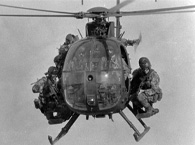
 "I just reached a breaking point. So I decided to do what every red-blooded American would do: overthrow the government."
"I just reached a breaking point. So I decided to do what every red-blooded American would do: overthrow the government."  n continued their resistance. If any one of them were compromised, they were to warn the others by any means necessary with one simple word: shopette.
n continued their resistance. If any one of them were compromised, they were to warn the others by any means necessary with one simple word: shopette. 
 In an operation that took about six minutes, soldiers entered the Modelo prison, neutralized Muse's would-be assassin and took their precious cargo to the roof.
In an operation that took about six minutes, soldiers entered the Modelo prison, neutralized Muse's would-be assassin and took their precious cargo to the roof.

 The rest of his time in the Air Force was spent first in the reserves before being activated again for the Korean War. After that, he became a test pilot, flying the B-47, B-52, and B-58 - the first strategic American bomber capable of flying at Mach 2.
The rest of his time in the Air Force was spent first in the reserves before being activated again for the Korean War. After that, he became a test pilot, flying the B-47, B-52, and B-58 - the first strategic American bomber capable of flying at Mach 2.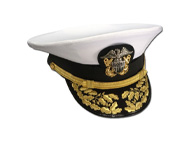
 Among those refugees was U.S. Navy Rear Adm. Huan Nguyen, the first Vietnamese-American ever to hold flag rank. Nguyen's road to becoming a distinguished Navy officer was a long and tragic one and began with one of the war's most iconic photographs.
Among those refugees was U.S. Navy Rear Adm. Huan Nguyen, the first Vietnamese-American ever to hold flag rank. Nguyen's road to becoming a distinguished Navy officer was a long and tragic one and began with one of the war's most iconic photographs.  Nine-year-old Huan Nguyen stayed next to his mother for two hours after the murders.
Nine-year-old Huan Nguyen stayed next to his mother for two hours after the murders.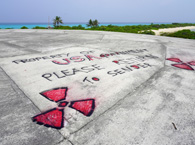
 Forty-three nuclear tests were fired at Enewetak from 1948 to 1958.
Forty-three nuclear tests were fired at Enewetak from 1948 to 1958. Wearing not much more than shorts, servicemembers used shovels, bulldozers, and other heavy equipment to scrap radioactive materials from the islands, breathing in deadly powder along the way. The plutonium-infested debris was dumped inside a crater from a previous test at Enewetak's Runit Island.
Wearing not much more than shorts, servicemembers used shovels, bulldozers, and other heavy equipment to scrap radioactive materials from the islands, breathing in deadly powder along the way. The plutonium-infested debris was dumped inside a crater from a previous test at Enewetak's Runit Island. What did the US servicemembers do?
What did the US servicemembers do? The personal impact:
The personal impact: What's next?
What's next?